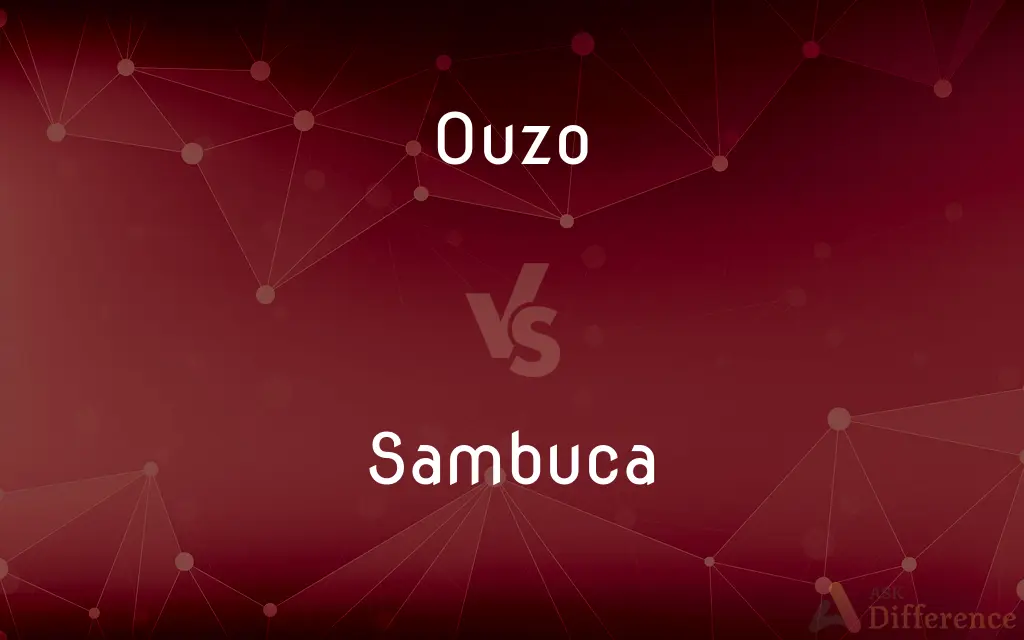Ouzo vs. Sambuca — What's the Difference?
By Tayyaba Rehman — Updated on September 4, 2023
Ouzo is a Greek anise-flavored aperitif, while Sambuca is an Italian anise-flavored liqueur often served with coffee beans.

Difference Between Ouzo and Sambuca
Table of Contents
ADVERTISEMENT
Key Differences
Ouzo and Sambuca are both renowned spirits, celebrated for their aniseed flavorings. While Ouzo finds its origins in Greece, Sambuca is Italian-born. Their geographical distinctions infuse them with unique cultural significances and consumption traditions that are emblematic of their respective countries.
When it comes to appearance, Ouzo stands out with its transformative nature. Initially clear, Ouzo turns a milky white when diluted with water or ice, due to its anise oil content. Sambuca, contrastingly, maintains a translucent or slightly syrupy disposition, irrespective of dilution. Though both are anise-flavored, the way they respond to mixers visually differentiates them.
The taste profiles of Ouzo and Sambuca are undeniably centered around anise. Yet, there are variations. Ouzo, though predominantly anise-flavored, may have subtle hints of other herbs or even mint. Sambuca, on the other hand, leans towards a sweeter profile and might be infused with additional flavors, such as elderflower or licorice. The sweetness of Sambuca often makes it more palatable to those unfamiliar with anise spirits.
Consumption traditions further distinguish Ouzo from Sambuca. In Greece, Ouzo is commonly sipped alongside a meze, a selection of small dishes. This ritual is not just about enjoying the drink but is deeply rooted in Greek culture, symbolizing hospitality and leisure. Sambuca in Italy is often presented with three coffee beans floating atop, denoting health, happiness, and prosperity. This liqueur is versatile, consumed straight, diluted, or even as an addition to coffee.
Lastly, the global recognition of Ouzo and Sambuca varies. Ouzo is iconic in Greek culture and is a staple in local celebrations. Travelers to Greece are often introduced to this spirit, making it a significant part of their experience. Sambuca, being Italian, enjoys broader global recognition, primarily due to the widespread popularity and influence of Italian cuisine and beverages. Both, however, are unique embodiments of their respective nation's spirit and culture.
ADVERTISEMENT
Comparison Chart
Origin
Greece
Italy
Flavor Base
Anise
Anise
Additional Flavors
Sometimes with a hint of mint or other herbs
Often has licorice or elderflower
Texture/Appearance
Turns milky-white when diluted
Clear to slightly syrupy
Traditional Use
Sipped during a meze
Served with coffee beans or added to coffee
Compare with Definitions
Ouzo
Ouzo is traditionally consumed during a meze.
The small taverna served a meze with their local Ouzo.
Sambuca
Sambuca is an Italian anise-based liqueur.
She ordered a shot of Sambuca after dinner.
Ouzo
Ouzo is a popular anise-flavored aperitif from Greece.
We enjoyed a glass of Ouzo by the sea at sunset.
Sambuca
Sambuca is often accompanied by three floating coffee beans.
The bartender served the Sambuca with three coffee beans, signifying good luck.
Ouzo
Ouzo often turns milky-white when diluted with water or ice.
He added water to his Ouzo, watching it cloud up.
Sambuca
Sambuca can be consumed straight, with water, or added to coffee.
He likes his espresso with a splash of Sambuca.
Ouzo
Ouzo is symbolic of Greek hospitality.
To welcome us, our host offered a glass of Ouzo.
Sambuca
Sambuca is notably sweeter than many other anise-flavored spirits.
She enjoyed the sweet taste of the Sambuca, finding it smooth.
Ouzo
Ouzo's distinct flavor is derived from anise seeds.
The strong taste of anise in the Ouzo was refreshing.
Sambuca
Sambuca sometimes has additional flavors like elderflower or licorice.
The unique blend of licorice in the Sambuca gave it an interesting twist.
Ouzo
Ouzo (Greek: ούζο, IPA: [ˈuzo]) is a dry anise-flavoured aperitif that is widely consumed in Greece and Cyprus. It is made from rectified spirits that have undergone a process of distillation and flavoring.
Sambuca
Sambuca (Italian pronunciation: [samˈbuːka]) is an Italian anise-flavoured, usually colourless, liqueur. Its most common variety is often referred to as white sambuca to differentiate it from other varieties that are deep blue in colour (black sambuca) or bright red (red sambuca).
Ouzo
A Greek aniseed-flavoured spirit.
Sambuca
An Italian aniseed-flavoured liqueur
A glass of flaming sambuca
A good few sambucas were consumed before he finally tottered into a taxi
Ouzo
A colorless, unsweetened Greek liqueur flavored with anise.
Sambuca
An ancient triangular stringed instrument.
Ouzo
(uncountable) An anise-flavoured aperitif, originating in Greece.
Sambuca
An Italian liqueur with the flavor of anise.
Ouzo
(countable) A serving of this drink.
Sambuca
An Italian liqueur made from elderberries and flavoured with licorice, traditionally served with 3 coffee beans that represent health, wealth and fortune (or past, present and future).
Ouzo
Anise-flavored Greek liquor
Sambuca
(musical instruments) An ancient form of triangular harp having a very sharp, shrill tone.
Sambuca
An ancient type of ship-borne siege engine.
Sambuca
An Italian liqueur made with elderberries and flavored with licorice
Common Curiosities
Where does Ouzo come from?
Ouzo originates from Greece.
How about Sambuca?
Sambuca is from Italy.
Is Ouzo always white?
No, Ouzo is clear but turns milky-white when mixed with water or ice.
What is the alcohol content of Ouzo and Sambuca?
Both vary by brand, but typically Ouzo has 37.5%-50% alcohol, while Sambuca ranges from 38%-42%.
Why is Sambuca sometimes served with coffee beans?
The coffee beans traditionally represent health, happiness, and prosperity.
Can Ouzo and Sambuca be used interchangeably in recipes?
While they both have anise as a base flavor, they have different profiles and sweetness levels, so they may alter the taste of a recipe.
Which is sweeter, Ouzo or Sambuca?
Sambuca is generally sweeter than Ouzo.
What is the main flavor of both Ouzo and Sambuca?
Both Ouzo and Sambuca have anise as their primary flavor.
Which is more popular globally, Ouzo or Sambuca?
Both have their own regional popularity, but Sambuca might be more recognized globally due to Italian cuisine's wide influence.
How is Ouzo traditionally consumed?
Ouzo is often sipped during a meze, a light Greek snack.
Are there variations of flavors within Ouzo or Sambuca brands?
Yes, some brands may incorporate other flavors or herbs.
How do locals in Greece and Italy prefer to drink Ouzo and Sambuca?
In Greece, Ouzo is enjoyed straight or with a splash of water, while in Italy, Sambuca is often consumed straight, with coffee, or diluted with water.
Is there any cultural significance to Ouzo in Greece?
Yes, Ouzo symbolizes Greek hospitality.
Do Ouzo and Sambuca have any medicinal uses?
Historically, both were sometimes believed to have medicinal properties, but they're primarily consumed for pleasure today.
Can Ouzo and Sambuca be used in cooking?
Yes, they can be used in various dishes, especially desserts, to impart an anise flavor.
Share Your Discovery

Previous Comparison
Inpatient vs. Impatient
Next Comparison
Nuggie vs. NoogieAuthor Spotlight
Written by
Tayyaba RehmanTayyaba Rehman is a distinguished writer, currently serving as a primary contributor to askdifference.com. As a researcher in semantics and etymology, Tayyaba's passion for the complexity of languages and their distinctions has found a perfect home on the platform. Tayyaba delves into the intricacies of language, distinguishing between commonly confused words and phrases, thereby providing clarity for readers worldwide.













































